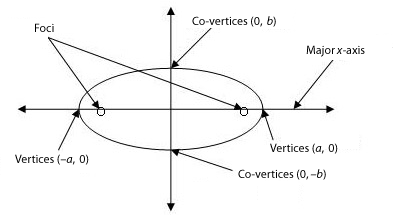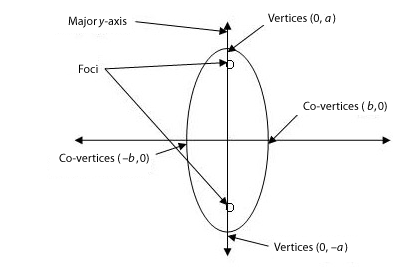 username@email.com
username@email.com
In this lesson, you will study the basics of three different conic sections: circles, parabolas, and ellipses.
Binomials can be expanded using two methods:
Intersecting a single or double cone with a geometric plane produces shapes called conic sections. In this lesson we will review three types of conic sections, or conics: circles, parabolas, and ellipses.
The standard form of the equation for a circle is
![]()
where r is the radius, (x, y) is the coordinate plane location for any point on the circle, and (h, k) is the coordinate plane location for the center of the circle.
If the circle is centered at the origin, then the equation simplifies to
![]() .
.
The following graph shows a circle centered at the origin, with a radius of 2. The equation of the circle is ![]() .
.
The following graph shows a circle centered at (3, 2), with a radius of 2. The equation of the circle is ![]() .
.
What is the equation of a circle with a radius of 3, centered at (–2, 4)?
The correct choice is A. We know that h = –2, k = 4, and the radius is 3. Using the standard form, the equation becomes ![]() .
.
Previously, we discussed parabolas and how they graphically reflect the behavior of quadratic equations. Now, we will look at the actual graphs themselves and some of the characteristics of parabolas in more depth.
Two parts of the graph that are important to identify are the directrix and the focus. The focus is a fixed point on the inside of a parabola, and the directrix is a fixed line on the outside of a parabola. The directrix is a line whose distance from the vertex is the same as the foci’s distance from the vertex. Any point on the graph of a parabola is the same distance from the focus as from the directrix.
The equation for the following graph is ![]() , where
, where ![]() .The constant c identifies the location of the focus and directrix.
.The constant c identifies the location of the focus and directrix.
In this graph, the focus is located at (0, 3), therefore c = 3. The directrix is ![]() . The equation of the parabola is
. The equation of the parabola is ![]() .
.
One example of a focus point that can be found in everyday objects is a flashlight. The bulb is seated at the focal point within the reflective surface, which is sort of like a parabola. Another example is a satellite dish. The receiver is located at the focal point, and the actual dish forms the shape of a parabola.
Parabolas can have four different configurations.
| Open upward: |
 |
| Open downward: |
 |
| Open left: |
 |
| Open right: |
 |
What is the equation of a parabola that opens upward and has a directrix at ![]() ?
?
The correct choice is B. If the directrix is ![]() , then the focus is (0, 2). Therefore, c = 2.
, then the focus is (0, 2). Therefore, c = 2.
The equation for a parabola that opens upward is
![]() .
.
If a geometric plane intersects a single cone at an angle, the result is an ellipse.
The following definitions pertain to ellipses:
The ellipse has two separate configurations, and therefore has two separate standard forms.

The standard form for an ellipse centered at zero with vertices on the x-axis and co-vertices on the y-axis is
![]()

The standard form for an ellipse centered at zero with co-vertices on the x-axis and vertices on the y-axis is
Step 1: Write the equation in standard form. To convert the equation to standard form, divide each term by 400.
Step 3: Since y is the major axis, the vertices are located at (0, 5) and (0, –5). The co-vertices are located at (–4, 0) and (4, 0).